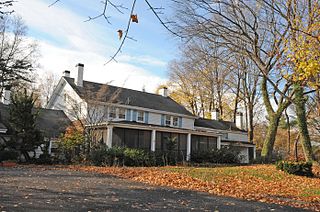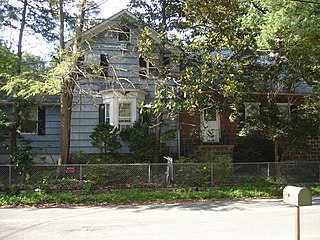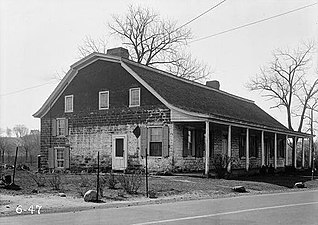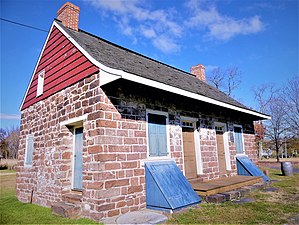
Friedrich Wilhelm August Heinrich Ferdinand von Steuben, also referred to as Baron von Steuben, was a Prussian military officer who played a leading role in the American Revolutionary War by reforming the Continental Army into a disciplined and professional fighting force. His contributions marked a significant improvement in the performance of American troops, and he is subsequently regarded as one of the fathers of the United States Army.

Fort Lee Historic Park is located atop a bluff of the Hudson Palisades overlooking Burdett's Landing, known as Mount Constitution, in Fort Lee, New Jersey, United States. Native Americans appear to have lived in the area for thousands of years before the arrival of Europeans. The bluff was the site of George Washington's 1776 encampment opposite Fort Washington at the northern end of Manhattan. Fort Lee is named for General Charles Lee. The site is a reconstruction of the encampment including the blockhouse, battery, quarters as well as a visitors center. It is part of Palisades Interstate Park.
New Bridge was a prosperous mill hamlet, centered upon a bridge strategically placed at the narrows of the Hackensack River. In the American Revolution, New Bridge Landing was the site of a strategic bridge crossing the Hackensack River, where General George Washington led his troops in retreat from British forces November 20, 1776. Eleven engagements took place here throughout the war. The current Draw Bridge at New Bridge was installed in 1889 and added to the National Register of Historic Places on July 5, 1989. The area is now a New Jersey historic site in portions of New Milford, River Edge, Hackensack and Teaneck in Bergen County, New Jersey, United States.

The New Milford Plant of the Hackensack Water Company was a water treatment and pumping plant located on Van Buskirk Island, an artificially created island in the Hackensack River, in Oradell, Bergen County, New Jersey, United States. The site was purchased in 1881 by the Hackensack Water Company, which developed it for water supply use. The facility was built between 1881 and 1911, and it includes a brick pumping station from 1882, a tall filtration tower, and huge underground infrastructure. The Hackensack Water Company was merged into United Water in the 1980s; the successor today is Suez North America.

The Campbell-Christie House is a historic home that has been relocated to New Bridge Landing in River Edge, Bergen County, New Jersey. It was added to the National Register of Historic Places on January 10, 1983, as part of the Early Stone Houses of Bergen County Multiple Property Submission (MPS).

The table below includes sites listed on the National Register of Historic Places in Bergen County, New Jersey except those in Closter, Franklin Lakes, Ridgewood, Saddle River and Wyckoff, which are listed separately. Latitude and longitude coordinates of the sites listed on this page may be displayed in a map or exported in several formats by clicking on one of the links in the box below the map of New Jersey to the right.

Seven Chimneys, also known as the Nicholas Zabriskie House, was built between 1745 and 1750 by Nicholas Zabriskie, an early Dutch settler in the Hudson Valley. It is the oldest house in Washington Township, Bergen County, New Jersey. Notable visitors include Theodore Roosevelt. The house was used as a stop on the Underground Railroad. Seven Chimneys was placed on the National Register of Historic Places in 1971.

Bergen County, New Jersey had a series of court houses. The current one stands in Hackensack, New Jersey.
Ackerman House may refer to:

Demarest station is located in Demarest, Bergen County, New Jersey, United States. The station's depot was added to the National Register of Historic Places on July 7, 2004.
Hopper House may refer to:

The bridge at New Bridge Landing, New Jersey was built in 1888 to replace an earlier wooden one, and was added to the National Register of Historic Places on July 5, 1989.

The Jacob Vanderbeck Jr. House, in Fair Lawn, Bergen County, New Jersey, United States, is a typical historic house of the American colonial architecture style called Dutch Colonial on Dunkerhook Road, adjacent to the Saddle River County Park. It sits on a bluff above the Saddle River and is approached from Dunkerhook Road via Barrister Court, a condominium development it is now part of. The house was added to the National Register of Historic Places on January 9, 1983.

The Albert J. Zabriskie Farmhouse is located at the current address of 7 East Ridgewood Avenue in Paramus, Bergen County, New Jersey, United States, just east of New Jersey Route 17. This is one of several Zabriskie historic sites associated with the descendants of prominent settler Albrycht Zaborowski (1638–1711). This stone house was built in 1805 by Albert Jacob Zabriskie (1760–1835) in the New Jersey Dutch style, owned by four generations of the family until 1924, and added to the National Register of Historic Places on November 7, 1977. Due to confusion from the street name and handwritten notes on one page of the NRHP nomination, the building is sometimes mistakenly listed as being in Ridgewood, New Jersey.

Jacobus Demarest House is located in New Milford, Bergen County, New Jersey, United States. The house was built in 1765 and was added to the National Register of Historic Places on February 17, 1978.

Demarest House is located in River Edge, Bergen County, New Jersey, United States. The house was added to the National Register of Historic Places on January 10, 1983, as part of the Early Stone Houses of Bergen County Multiple Property Submission (MPS).

The Zabriskie Tenant House was a historic house of the American colonial architecture style called Dutch Colonial on Dunkerhook Road in Paramus, in Bergen County, New Jersey, United States, adjacent to the Saddle River County Park. The Zabriskie family, who farmed much of the area to the east of the Saddle River, built the home to house their domestic workers. It was one of the few structures left in New Jersey directly related to free African American communities in the state, and was a remnant of an African American Dunkerhook community that included several homes and an A.M.E. Church. The house was added to the National Register of Historic Places on July 24, 1984.

The Staats House, also known as the General Baron von Steuben Headquarters, is a historic building located at 17 Von Steuben Lane in South Bound Brook, Somerset County, New Jersey. Constructed c. 1740, it is now known as the Abraham Staats House after its second owner. In 1779, during the second Middlebrook encampment of the American Revolutionary War, it served as the headquarters for Prussian-American General Friedrich Wilhelm von Steuben. The house was added to the National Register of Historic Places on December 4, 2002, and noted as representing "one of the finest remaining buildings from the second phase of Dutch immigration and settlement in the Raritan Valley".

The Kingston Mill Historic District is a 49-acre (20 ha) historic district in Kingston, New Jersey. It is roughly bounded by Herrontown, River, and Princeton-Kingston Roads in the townships of Princeton in Mercer County, South Brunswick in Middlesex County, and Franklin in Somerset County. It was added to the National Register of Historic Places on April 10, 1986 for its significance in engineering, exploration/settlement, industry, and transportation. The district includes 16 contributing buildings and 2 contributing structures.

























